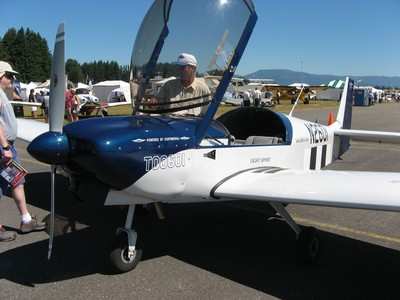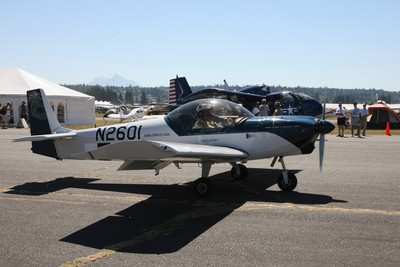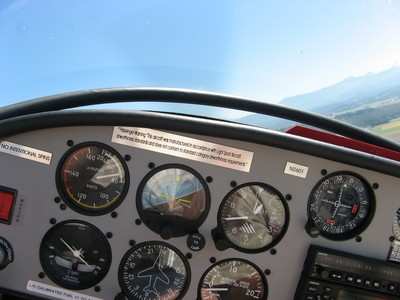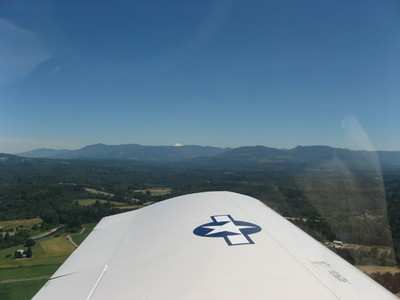Part Two: AMD CH601 XL Zodiac
by ANN Managing Editor Rob Finfrock
Over the past 10 months, I've had the opportunity to spend some
seat time in three emerging players in the light sport aircraft
segment. As a former Cessna 172 jockey, I must admit I wasn't
expecting much when I first took to the skies on demo flights in
three significantly smaller aircraft, lower-powered aircraft... but
wow, was I wrong.

These reports are NOT flight tests -- I'll leave the heavy
lifting around here to Jim -- but rather my impressions of these
aircraft from the perspective of a student pilot, looking at LSA as
an option to continue and expand my flight training... the same way
other potential sport pilot entrants will likely approach the
segment.
With that in mind...
Aircraft Manufacturing and Development (AMD) CH601 XL
Zodiac
I flew the all-American Zodiac in Arlington, WA during the NWEAA
Fly-In last July... as impressive a flight venue as you're likely
to see.

Whereas the StingSport is all about
smooth composite surfaces and advanced technology, the all-metal
Zodiac is resolutely low-tech by comparison, an excellent example
of designer Chris Heintz's philosophy to "keep it simple and keep
it light." That, and another axiom -- "if it works, don't fix it"
-- have served the design well on the homebuilt market, and also
simplified the entry of the S-LSA certified model into the light
sport segment. (The StingSport is also based on a homebuilt
aircraft.)
Something of a rarity is the certified Zodiac's powerplant of
choice: a FAR 33-certified Continental O-200, same as you'll find
in Cessna 150. Unlike the Rotax 912s seen on several other entries,
the trusty 100-horse Continental is a rather conventional,
low-revving engine, that also carries the added advantage of
service availability: nearly any mechanic you'd ever see will be
able to work on it. For homebuilders, engine choices as diverse as
a six cylinder, 110-hp Jabiru 3300, Lycoming O-235 (116-hp), or and
Rotax 912S (100-hp) are also available.

Unlike several LSA competitors, the Zodiac I flew also sported a
true, full-sized, classic-six steam gauge arrangement,
front-and-center, with engine instruments to the right. Anyone
transitioning from an older Cessna or Piper should feel right at
home with this layout (although glass flight instrumentation is one
of many options available.) Like the Sting, the Zodiac features
electric trim control on the dual control sticks.

As far as flying impressions, I felt the Zodiac flew like a
heavier plane... due mostly to its somewhat more deliberate
response in turns compared to the sprightly Sting. The Zodiac was
quite eager to please, though... and to me, the slower control
responses were quite comforting and familiar. In fact, it seemed to
fly much like the trusty old Skyhawk does, albeit in a
low-wing.
And that's not a bad tradeoff, especially for beginning pilots.
While AMD hasn't made much of a dent in the training market (to
date, just one facility -- Silver Sky Aviation of Phoenix, AZ --
uses a Zodiac for primary flight training, according to the
company's website), the CH601 XL seems to be a natural for that
segment, given its flight behavior and ease of service.

Top speed for the Zodiac is listed as 113 knots, with a no-flap
stalling speed of 45 KIAS (use of flaps drops that figure to 38
knots.) AMD states the Zodiac can climb at an honest 1,000
feet-per-minute, a figure that bests several other LSAs by at least
100 FPM, and the plane can go close to 690-nm on one 30-gallon fuel
load. The basic VFR airplane boasts a 550-lb useful load.
Compared to the StingSport, the Zodiac carries a significant
pricing advantage: $79,900 for a stripped, VFR-only Zodiac XL;
stepping up to the IFR-capable XLi model will run you about $15,000
more. Several available options can bump the price on either plane
to over $100,000, however, bringing it relatively inline with
competitive planes.

The word that comes to mind repeatedly when contemplating
the Zodiac is "honest": honest construction, honest presentation,
and honest flight characteristics. That may sound like damning with
faint praise... but there are certainly worse things to call an
airplane.
Coming Saturday... The Evektor SportStar
 Aero-News: Quote of the Day (04.27.25)
Aero-News: Quote of the Day (04.27.25) ANN's Daily Aero-Linx (04.27.25)
ANN's Daily Aero-Linx (04.27.25) Classic Aero-TV: Veteran's Airlift Command -- Serving Those Who Served
Classic Aero-TV: Veteran's Airlift Command -- Serving Those Who Served Airborne-NextGen 04.22.25: NYC eVTOL Network, ForgeStar-1, Drone Safety Day
Airborne-NextGen 04.22.25: NYC eVTOL Network, ForgeStar-1, Drone Safety Day Airborne 04.21.25: Charter Bust, VeriJet Woes, Visual Approach Risks
Airborne 04.21.25: Charter Bust, VeriJet Woes, Visual Approach Risks








